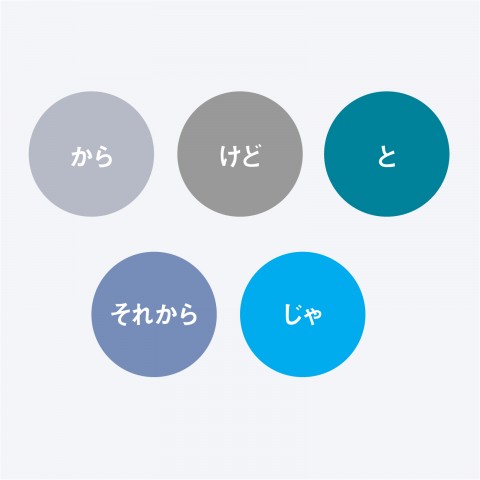If you’re learning Japanese grammar, you may be surprised by how many variations there are of Japanese conjunctions and Japanese connective particles, and how they vary depending on the use of sentences.
When you think about speaking your mother tongue, the flow of your sentences is very natural, without redundancy or lack of words. This is because you can use conjunctions effectively and naturally to connect sentences.
In this way, in Japanese grammar, conjunctions are one of the most essential parts of speech. When you master Japanese conjunctions, you’ll be able to speak Japanese quite fluently!
By the end of this article, you should have a better idea about Japanese conjunctions meaning, how to use Japanese conjunctions, and have an increased Japanese conjunction vocabulary!
Here are some of the most basic and useful Japanese conjunctions and connectives. Let’s enjoy learning here at JapanesePod101.com!

Table of Contents
- What is a Conjunction?
- Conjunctions to Correlate Similar Thoughts
- Conjunctions to Express Condition
- Conjunctions to Express Cause
- Conjunctions to Express Opposition
- Conjunctions to Express Choices
- Other Useful Japanese Conjunctions
- Conclusion: How JapanesePod101 Can Help You Learn More Japanese
1. What is a Conjunction?
Conjunctions are words that connect and conjoin phrases, clauses, or sentences together. A conjunction word doesn’t have a meaning itself, much like prepositions. Conjunctions in Japanese function similarly to how they do in English.
The conjunction in Japanese is usually a particle or postposition that’s usually used at the end of the dependent clause(s), determining the relationship of the conjoined clauses. Examples of these relationships include copulative, disjunctive, adversative, and conclusive.
For example, here are the most common Japanese conjunctions by type:
- Copulative Conjunctions: The conjunctive relation of units that expresses the addition and/or connection of meanings.
And:
と、(to)
や、 (ya)
そして (soshite)Also:
も、(mo)
もまた (mo mata)Then:
そして、 (soshite)
それから (sorekara)Or:
または、(mata wa)
また (mata) - Disjunctive Conjunctions: The conjunctive relation of units that expresses the disjunction of their meanings.
-or, -or : -ka, -ka ‥か、‥か
-and, -and : -ya, -ya ‥や、‥や - Adversative Conjunctions: The conjunctive relation of units that expresses the opposition of their meanings.
But:
しかし、(shikashi)
が、(ga)
けど (kedo)
けれども (keredomo)
なのに (nanoni)
でも (demo)However:
しかしながら、 (shikashinagara)
ところが (tokoroga)
Despite:
にもかかわらず (nimokakawarazu) - Conclusive Conjunctions
So:
それで、(sorede)
なので (nanode)And then:
それから、(sorekara)
その後 (sonogo)Therefore:
それゆえに、(soreyue ni)
だから、(dakara)
したがって (shitagatte)Thus:
ゆえに、(yue ni)
したがって (shitagatte)
There are exceptions where Japanese language conjunctions can’t be used to connect equivalent clauses or sentences. However, we’ll explain the basic and most important Japanese conjunctions in this article.
Japanese conjunctions have a wide range of variations
2. Conjunctions to Correlate Similar Thoughts
Here are the commonly used Japanese conjunctions which connect clauses/sentences with a function of addition.
1- と (to)
- Meaning: This word means “and.” It simply adds one thing to another.
- Usage:と(to) is used when you list everything that’s applicable. と (to) can only be used to connect nouns.
- Example:
テーブルの上にりんごとみかんとバナナがあります。
Tēburu no ue ni ringo to mikan to banana ga arimasu.
There are apples, oranges, and bananas on the table.- In this case, there are only apples, oranges, and bananas on the table.
2- や (ya)
- Meaning: This word means “and.” It adds one thing to another.
- Usage: や (ya) is similar to と (to), but it’s used when you list only some parts of a whole, which are applicable. や (ya) can only be used to connect nouns.
- Example:
テーブルの上にりんごやみかんがあります。
Tēburu no ue ni ringo ya mikan ga arimasu.
There are apples and oranges on the table.- The translation in English is the same as that for the example for と (to). In this case, however, it implies that there are things besides the apple and orange on the table.
3- そして (soshite)
- Meaning: This word means “and.” It adds things to each other, like the last words. It can also mean “thus” and “and then.”
- Usage: そして (soshite) is used to add noun(s), or to explain an action that follows.
- Example:
テーブルの上にりんごとみかん、そしてバナナがあります。
Tēburu no ue ni ringo to mikan, soshite banana ga arimasu.
There are apples, oranges, and bananas on the table.私はりんごを食べます。そしてみかんも食べます。
Watashi wa ringo o tabemasu. Soshite mikan mo tabemasu.
I’ll eat an apple. And then I’ll eat an orange, too.
3. Conjunctions to Express Condition
There are several variations of Japanese conjunctions which are used to introduce a conditional clause.
1- もし (moshi)
- Meaning: It means simply “if,” but it can also mean “in case” and “supposing.”
- Usage: When using もし (moshi), the end of a sentence should be conjugated to the conditional form, such as: たら (-tara), なら (-nara), ならば (-naraba), or すると (-suruto).
When the conditional form is emphasized, it’s possible to omit もし (moshi) and the sentence still keeps the expression of condition.
- Example:
もし明日雨が降るなら、ピクニックは中止です。
Moshi ashita ame ga furu nara, pikunikku wa chūshi desu.
If it rains tomorrow, the picnic will be cancelled.
2- たら (tara)
- Meaning: This word means “if,” and it denotes a condition.
- Usage: As mentioned above, たら (-tara) is used at the end of a clause/sentence, along withもし (moshi) at the beginning. It’s usually used to express a relationship of assumption, as well as a specific and one-time consequence.
- Example:
もし時間があったら、映画を見たいです。
Moshi jikan ga attara, eiga o mitai desu.
If I have time, I want to watch a movie.
3- なら (nara)
- Meaning: This word means “if,” and it denotes a condition.
- Usage: なら (-nara) is also used at the end of a clause/sentence, along withもし (moshi) at the beginning.
Unlike たら (-tara), なら (-nara) is usually used to express a speaker’s decision, order, hope, or opinion of assumption when assuming a certain thing.
- Example:
京都へ行くなら、新幹線で行きたいです。
Kyōto e iku nara, Shinkansen de ikitai desu.
If I go to Kyoto, I want to go by Shinkansen.
4- すると (suruto)
- Meaning: This word means “if,” and it denotes a condition.すると (suruto) can also mean “then.”
- Usage: When using すると (suruto) as a conditional conjunction, と (to) or だと (da to) usually come in front of it. It expresses a relationship of assumption and a consequence.
- Example:
彼が間に合わないとすると、私たちは会議を始められません。
Kare ga maniawanai to suruto, watashi-tachi wa kaigi o hajimeraremasen.
If he can’t come in time, we can’t start a meeting.
When you use conjunctions effectively, conversations will go smoothly.
4. Conjunctions to Express Cause
There’s also a number of Japanese conjunctions which are used to express cause. Combining two clauses/sentences with the following conjunctions denotes a reason and result. In Japanese grammar, note that the clause/sentence that states the reason comes first.
1- だから (da kara) / から (kara)
- Meaning: This word can mean “so,” “therefore,” or “thus.”
- Usage: だから (da kara) and から (kara) are very similar. However, a noun usually comes in front of だから (da kara), and an adjective or verb comes before から (kara).
- Example:
明日は日曜日だから 仕事はしません。
Ashita wa nichi-yōbi da kara shigoto wa shimasen.
Tomorrow is Sunday, so I don’t work.太るからケーキは食べません。
Futoru kara kēki wa tabemasen.
I will get fat, so I don’t eat cakes.
When considering the word order in Japanese grammar, it’s easier to remember the meaning as “so” rather than “because,” to match the order in English grammar.
2- ので (node)
- Meaning: This word means “so” or “thus.”
- Usage: ので (node) is used the same way as から (kara), but ので (node) is somewhat more polite.
- Example:
辛いので食べられません。
Karai node taberaremasen.
It is spicy, so I can’t eat it.
3- ため (tame) / のため (no tame)
- Meaning: This word can mean “because (of) …” or “as a consequence of …”
- Usage: Both ため (tame) and のため (no tame) have the same meaning, but an adjective or verb usually comes before ため (tame), and a noun comes in front of のため (no tame).
- Example:
宝くじが当たったため、私は車を買いました。
Takarakuji ga atatta tame, watashi wa kuruma o kaimashita.
I bought a car because I won the lottery.雪のため電車は遅れました。
Yuki no tame densha wa okuremashita.
Because of the snow, the train was delayed.
4- なぜなら (nazenara)
- Meaning: This word means “because.”
- Usage: When you use なぜなら (nazenara), please remember that a sentence of a particular situation comes before なぜなら (nazenara), and a sentence to explain why follows it. It often comes with だから (da kara) or から (kara) to explain why.
- Example:
彼女は怒って帰りました。なぜなら彼氏が浮気したのを知ったからです。
Kanojo wa okotte kaerimashita. Nazenara kareshi ga uwaki shita no o shitta kara desu.
She got angry and left, because she came to know her boyfriend had cheated on her.
In order to learn which conjunction is appropriate to use and in what situation, try to listen to how Japanese people use Japanese conjunctions in various situations.
5. Conjunctions to Express Opposition
Here are several examples of Japanese conjunctions which are used to denote contrast.
1- しかし (shikashi) / でも (demo)
- Meaning: This word means “but” or “however.”
- Usage: Both しかし (shikashi) and でも (demo) are the most commonly used conjunctions to express opposition. They usually come at the beginning of a sentence and refer to the statement which was mentioned before. しかし (shikashi) is often used in formal situations, while でも (demo) is more casual and colloquial.
- Example:
気温は低く寒いです。しかし、 花が咲きました。
Kion wa hikuku samui desu. Shikashi, hana ga sakimashita.
The temperature is low and it’s cold. However, flowers bloom.外は暖かい。でも、風は冷たい。
Soto wa atatakai. Demo, kaze wa tsumetai.
It is warm outside. But the wind is cold.
2- が (ga) / だが (daga)
- Meaning: This word means “but” or “however.”
- Usage: が (ga) and だが (daga) are almost the same, but が (ga) is used to conjoin separate sentences with a comma, and だが (daga) is often used at the beginning of a sentence.
- Example:
お金はあるが、旅行する時間がない。
O-kane wa aru ga, ryokō suru jikan ga nai.
I have money, but I don’t have time to travel.春は好きです。だが、夏は好きではないです。
Haru wa suki desu. Daga, natsu wa suki de wa nai desu.
I like spring. But I don’t like summer.
3- ところが (tokoroga) / なのに (nanoni)
- Meaning: This word means “but” or “however.”
- Usage: ところが (tokoroga) and なのに (nanoni) have similar meanings which express reverse conditions. They have a nuance of surprise, or sometimes complaint, which contrasts the expectation. ところが (tokoroga) is more formal, while なのに (nanoni) is used in a casual way and in colloquial speech.
- Example:
彼女は勉強をしなかった。とことろが、試験に受かった。
Kanojo wa benkyō o shinakatta. Tokoroga, shiken ni ukatta.
She did not study. But she passed the examination.彼は先生だ。なのに、英語を話せない。
Kare wa sensei da. Nanoni, eigo o hanasenai.
He is a teacher. But he can’t speak English.
4- けど (kedo) / けれども (keredomo)
- Meaning: This word can mean “but,” “however,” “though,” and “although.”
- Usage: While しかし (shikashi) and でも (demo) are often used at the beginning of a sentence with a comma, けど (kedo) and けれども (keredomo) are used to conjoin two separate sentences to express reverse conditions.
けど (kedo) and けれどもけど (keredomo) are almost the same. However, けれども (keredomo) is slightly more formal and polite, while けど (kedo) is often used in a casual way and in colloquial speech.
- Example:
外は暖かいけど、風は冷たい。
Soto wa atatakai kedo, kaze wa tsumetai.
It is warm outside, but the wind is cold.私は1ヶ月お菓子を食べなかったけれども、痩せなかった。
Watashi wa ikkagetsu o-kashi o tabenakatta keredomo, yasenakatta.
Although I didn’t eat snacks for a month, I didn’t lose weight.
6. Conjunctions to Express Choices
Here are some basic Japanese conjunctions which are used to express choices and alternatives.
1- または (matawa) / もしくは (moshikuwa)
- Meaning: This word means “or” or “otherwise.”
- Usage: These conjunctions are used when you want to show options for something. または (matawa) and もしくは (moshikuwa) are very similar, and there’s not much difference in their meaning and usage. または (matawa) is more common and is used more often than もしくは (moshikuwa).
- Example:
電車またはバスで行きます。
Densha matawa basu de ikimasu.
I will go by train or bus.クレジットカードもしくは、電子決済でお支払いください。
Kurejitto cādo moshikuwa, denshi kessai de o-shiharai kudasai.
Please pay by credit card or through an electric payment.
2- か (ka)
- Meaning: This word means “or,” or “whether…or.”
- Usage: か (ka) is almost the same in meaning as the English word “or.” With this meaning, か (ka) is usually used twice in a sentence to indicate alternatives.
- Example:
今レストランは開いているか、 閉まっているか、知っていますか。
Ima resutoran wa aite iru ka, shimatte iru ka, shitte imasu ka.
Do you know if the restaurant is open or closed now?
3- あるいは (aruiwa)
- Meaning: This word means “or” or “alternatively.”
- Usage: あるいは (aruiwa) is another Japanese conjunction to express a choice between A or B. This is often used to show things which are of the same or similar kind. It has a nuance of “alternatively.”
- Example:
私は来年大阪あるいは名古屋へ転勤になります。
Watashi wa rainen Ōsaka aruiwa Nagoya e tenkin ni narimasu.
I will be transferred to Osaka or Nagoya next year.
Some Japanese conjunctions are only used in colloquial speech, and some are mostly used in formal settings.
7. Other Useful Japanese Conjunctions
It is good to know other useful Japanese conjunctions to improve your conversation skills. Here are some commonly used expressions.
1- ところで (tokorode)
- Meaning: This word means “by the way.”
- Usage: This phrase is often used when you change the topic in a conversation, and it’s generally used before asking a question.
- Example:
ところで、今週末は何か予定ありますか。
Tokorode, konshūmatsu wa nani ka yotei arimasu ka.
By the way, do you have any plans for this weekend?
2- 一方で (ippō de)
- Meaning: This phrase can mean “on the other hand,” “while,” or “meanwhile.”
- Usage: 一方で (ippō de) is used to indicate that the following sentence will be in a direction different from the previous sentence. The following sentence doesn’t necessarily have to be completely opposite from the previous one. 一方で (ippō de) can be also be used to mean “while” or “meanwhile.”
- Example:
彼女は寿司が好きです。一方で彼はピザが好きです。
Kanojo wa sushi ga suki desu. Ippō de kare wa piza ga suki desu.
She likes sushi. On the other hand, he likes pizza.
3- 例えば (tatoeba)
- Meaning: This means “for example.”
- Usage: This phrase can be used exactly the same as “for example” in English. It’s used when you want to give examples.
- Example:
私の趣味はスポーツです。例えば、水泳とテニスが好きです。
Watashi no shumi wa supōtsu desu. Tatoeba, suiei to tenisu ga suki desu.
My hobby is sports. For example, I like swimming and tennis.
4- さらに (sarani) / その上 (sonoue)
- Meaning: These words can mean “in addition” and “moreover.”
- Usage: Bothさらに (sarani) and その上 (sonoue) are used when you want to add something. その上 (sonoue) has a slightly stronger emphasis thanさらに (sarani).その上 (sonoue) is literally translated as “on top of that.”
- Example:
日曜日に買い物へ行き、さらにジムへ行きました。
Nichi-yōbi ni kaimono e iki, sarani jimu e ikimashita.
I went shopping, and moreover, I went to the gym on Sunday.日曜日に買い物へ行き、さらにジムへ行きました。その上、夜は映画を見に行きました。
Nichi-yōbi ni kaimono e iki, sarani jimu e ikimashita. Sonoue, yoru wa eiga o mi ni ikimashita.
I went shopping, and in addition, I went to the gym on Sunday. Moreover, I went to see the movie.
Please see our article on Must-Know Adverbs and Phrases for Connecting Thoughts for more examples with audio.
8. Conclusion: How JapanesePod101 Can Help You Learn More Japanese
I hope this Japanese conjunctions list is helpful for your Japanese language studies. By learning Japanese conjunctions, your conversation skills will improve a lot, and you can enjoy speaking Japanese much more!
Which conjunctions do you plan on using soon? Which ones are you still struggling with? Let us know in the comments!
If you’re keen on learning more about the Japanese language, you’ll find more useful content on JapanesePod101.com. We provide a plethora of free lessons for you to help you boost your Japanese language skills, regardless of your current skill level:
- Themed vocabulary lists
- More insightful blog posts like this one
- Mobile apps to learn Japanese anywhere
- A MyTeacher program for Premium Plus members
- Much, much more!
All of your studying and practice will pay off, and soon you’ll be speaking and writing in Japanese like a native! And SpanishPod101 will be here throughout your language-learning journey with support and effective lesson materials!
Best wishes, and happy learning!





















